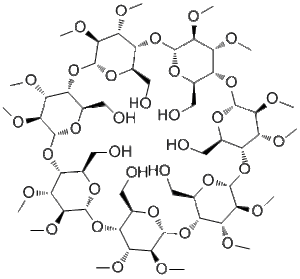This product is for research use only, not for human use. We do not sell to patients.

| Size | Price | Stock |
|---|---|---|
| 25g | $100 | 3-6 Days |
| 50g | $150 | 3-6 Days |
| 100g | $250 | 3-6 Days |
| 200g | $450 | 3-6 Days |
Cat #: V33326 CAS #: 128446-36-6 Purity ≥ 99%
Description: Methyl-β-cyclodextrin, the randomly methylated form of β-cyclodextrin, is a cyclic heptasaccharide used to improve the water solubility of non-polar compounds such as fatty acids, lipids, vitamins and cholesterol for use in cell culture applications and to extract cholesterol from lipid membranes. As a cyclic heptasaccharide, it can also be used to deliver hydrophobic drugs based on its property of solubilizing non-polar substances. Methyl-β-cyclodextrin is also extensively used as a cholesterol-depleting reagent. Methyl-β-cyclodextrin strongly reduces clathrin-dependent endocytosis.
Publications Citing InvivoChem Products
Product Promise

- Physicochemical and Storage Information
- Protocol
- Related Biological Data
- Stock Solution Preparation
- Quality Control Documentation
| Molecular Weight (MW) | 1303.303 |
|---|---|
| Molecular Formula | C54H94O35 |
| CAS No. | 128446-36-6 |
| Protocol | In Vitro | Cyclodextrins are a family of cyclic oligosaccharides with a hydrophilic outer surface and a lipophilic central cavity. Cyclodextrins molecules are relatively large with a number of hydrogen donors and acceptors and, thus in general, they do not permeate lipophilic membranes. In the pharmaceutical industry, cyclodextrins have mainly been used as complexing agents to increase aqueous solubility of poorly soluble drugs and to increase their bioavailability and stability. Cyclodextrins are used in pharmaceutical applications for numerous purposes, including improving the bioavailability of drugs[2]. Methyl-β-cyclodextrin quickly induces caspase-dependent apoptosis in PEL cells via cholesterol depletion from the plasma membrane. Methyl-β-cyclodextrin inhibits the growth of all PEL cell lines in a dose-dependent manner. The IC50 is 3.33-4.23 mM in each cell line[1]. Methyl-b-cyclodextrin is a highly water soluble cyclic heptasaccharide consisting of a β-glucopyranose unit, has been reported as the most effective agent for the depletion of cholesterol from cells among the various cholesterol-depleting agents[1]. |
|---|---|---|
| In Vivo | In a PEL xenograft mouse model, methyl-b-cyclodextrin significantly inhibits the growth and invasion of PEL cells without apparent adverse effects. Methyl-b-cyclodextrin-treated mice appears to be healthy, whereas non-treated mice has a distended abdominal region. The body weights of control are significantly higher than those of M-b-CyD treated mice. Methyl-b-cyclodextrin-treated mice has a significantly lower volume of ascites than that of non-treated mice[1]. Studies in both humans and animals have shown that cyclodextrins can be used to improve drug delivery from almost any type of drug formulation. Currently, there are approximately 30 different pharmaceutical products worldwide containing drug/cyclodextrins complexes in the market[2]. |
| Solvent volume to be added | Mass (the weight of a compound) | |||
|---|---|---|---|---|
| Mother liquor concentration | 1mg | 5mg | 10mg | 20mg |
| 1mM | 0.7673 mL | 3.8364 mL | 7.6728 mL | 15.3456 mL |
| 5mM | 0.1535 mL | 0.7673 mL | 1.5346 mL | 3.0691 mL |
| 10mM | 0.0767 mL | 0.3836 mL | 0.7673 mL | 1.5346 mL |
| 20mM | 0.0384 mL | 0.1918 mL | 0.3836 mL | 0.7673 mL |
This equation is commonly abbreviated as: C1 V1 = C2 V2
- (1) Please be sure that the solution is clear before the addition of next solvent. Dissolution methods like vortex, ultrasound or warming and heat may be used to aid dissolving.
- (2) Be sure to add the solvent(s) in order.




































